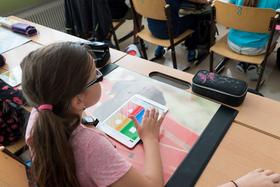For the 2025 school year, there are 4 public elementary schools serving 1,159 students in Warren County Schools School District. This district's average elementary testing ranking is 1/10, which is in the bottom 50% of public elementary schools in North Carolina.
Public Elementary Schools in Warren County Schools School District have an average math proficiency score of 17% (versus the North Carolina public elementary school average of 50%), and reading proficiency score of 27% (versus the 49% statewide average).
Minority enrollment is 88% of the student body (majority Black), which is more than the North Carolina public elementary school average of 57% (majority Black and Hispanic).
Overview
This School District
This State (NC)
# Schools
6 Schools
2,174 Schools
# Students
1,686 Students
1,091,007 Students
# Teachers
109 Teachers
73,903 Teachers
Student : Teacher Ratio
15:1
15:1
Student By Grade
District Rank
Warren County Schools School District, which is ranked within the bottom 50% of all 320 school districts in North Carolina (based off of combined math and reading proficiency testing data) for the 2021-2022 school year.
The school district's graduation rate of 77% has increased from 70-74% over five school years.
Overall District Rank
#303 out of 325 school districts
(Bottom 50%)
(Bottom 50%)
Math Test Scores (% Proficient)
(21-22)18%
51%
Reading/Language Arts Test Scores (% Proficient)
30%
50%
Science Test Scores (% Proficient)
36%
63%
Graduation Rate
(21-22)65-69%
86%
Students by Ethnicity:
Diversity Score
0.52
0.72
% American Indian
6%
1%
% Asian
1%
4%
% Hispanic
10%
21%
% Black
67%
25%
% White
11%
43%
% Hawaiian
n/a
n/a
% Two or more races
5%
6%
All Ethnic Groups
District Revenue and Spending
The revenue/student of $17,240 is higher than the state median of $11,187. The school district revenue/student has grown by 6% over four school years.
The school district's spending/student of $15,848 is higher than the state median of $11,612. The school district spending/student has grown by 6% over four school years.
Total Revenue
$29 MM
$17,307 MM
Spending
$27 MM
$17,964 MM
Revenue / Student
$17,240
$11,187
Spending / Student
$15,848
$11,612
Best Warren County Schools School District Public Elementary Schools (2025)
School
(Math and Reading Proficiency)
(Math and Reading Proficiency)
Location
Grades
Students
Rank: #11.
Vaughan Elementary School
(Math: 25-29% | Reading: 30-34%)
Rank:
Rank:
2/
Bottom 50%10
2936 Us Hwy 158e
Macon, NC 27551
(252) 257-6802
Macon, NC 27551
(252) 257-6802
Grades: PK-5
| 157 students
Rank: #22.
Northside Elementary School
(Math: 20% | Reading: 28%)
Rank:
Rank:
1/
Bottom 50%10
164 Elementary Ave
Norlina, NC 27563
(252) 456-2656
Norlina, NC 27563
(252) 456-2656
Grades: PK-5
| 309 students
Rank: #33.
Warren County Middle School
(Math: 13% | Reading: 30%)
Rank:
Rank:
1/
Bottom 50%10
118 Campus Drive
Warrenton, NC 27589
(252) 257-3751
Warrenton, NC 27589
(252) 257-3751
Grades: 6-8
| 368 students
Rank: #44.
Mariam Boyd Elementary School
(Math: 15-19% | Reading: 15-19%)
Rank:
Rank:
1/
Bottom 50%10
203 Cousin Lucy's Lane
Warrenton, NC 27589
(252) 257-3695
Warrenton, NC 27589
(252) 257-3695
Grades: PK-5
| 325 students
Recent Articles

The 15 Biggest Failures of the American Public Education System
The world is in a constant state of change and those who fail to adjust fall behind. Unfortunately, the American public education system has not kept up with the times and is currently facing a number of serious problems. Keep reading to learn about the biggest failures affecting the modern U.S. public education system as well as some of the trends that could spark change.

Florida Governor Calls for More Funding for State鈥檚 Public School System
Florida Governor Rick Scott has introduced a state budget for next year that pumps one billion more dollars into the public school system. We鈥檒l look at his reasons for the increase and the responses to the proposal.

Can Your Child鈥檚 School Meet the National Standards?
The article discusses the challenges public schools face in meeting national educational standards. It examines current performance trends, identifies key issues affecting student achievement, and explores potential solutions for improving academic outcomes across U.S. public schools.





